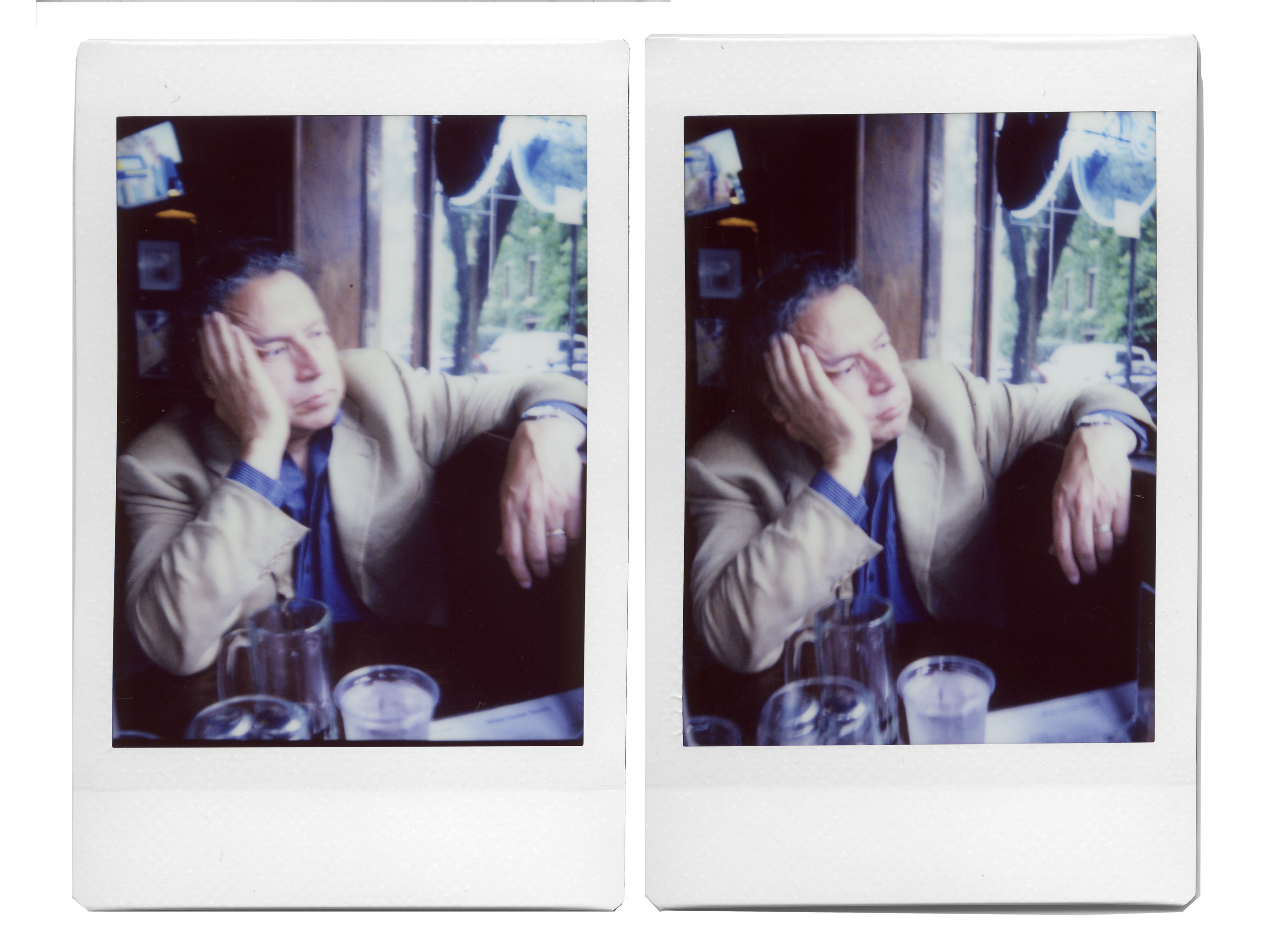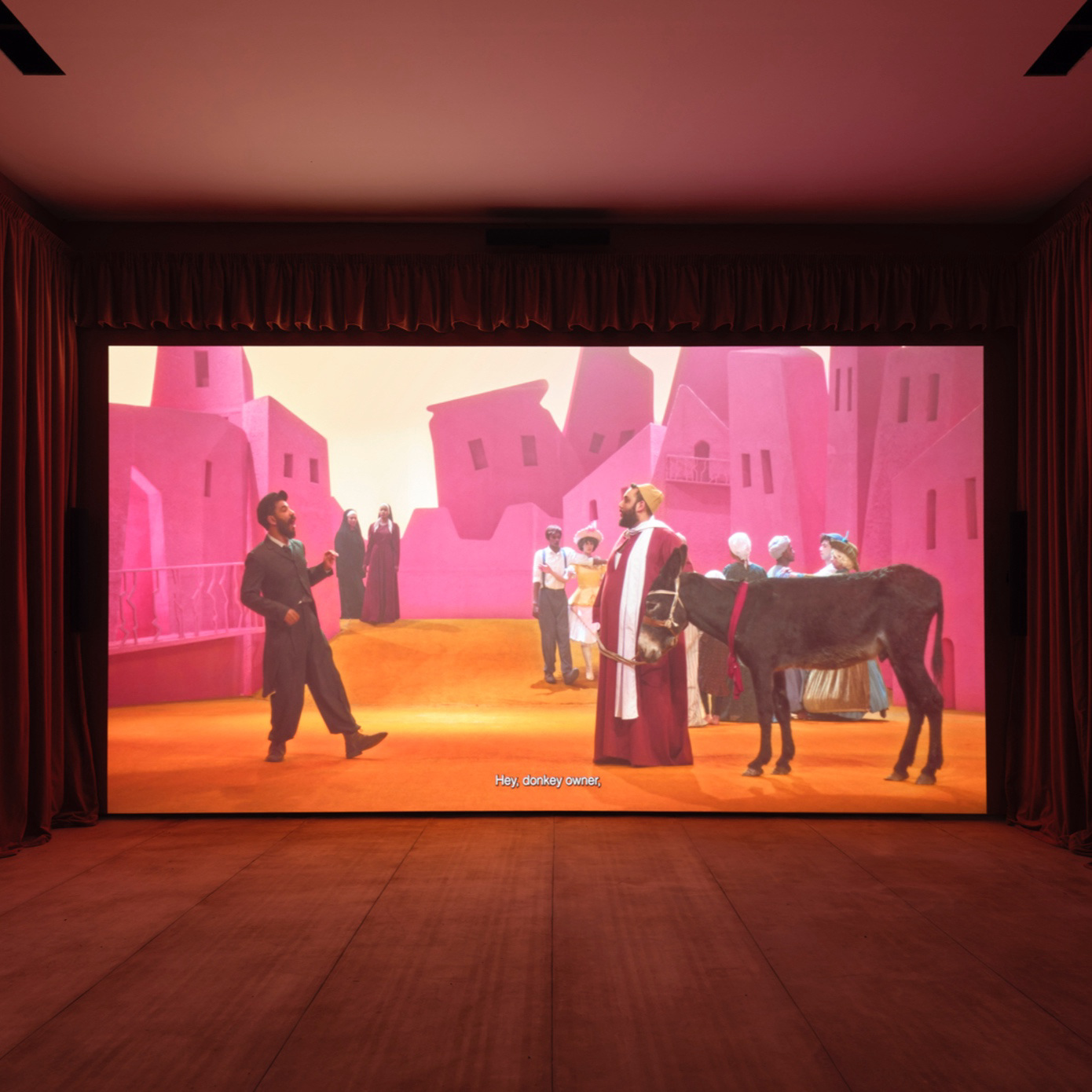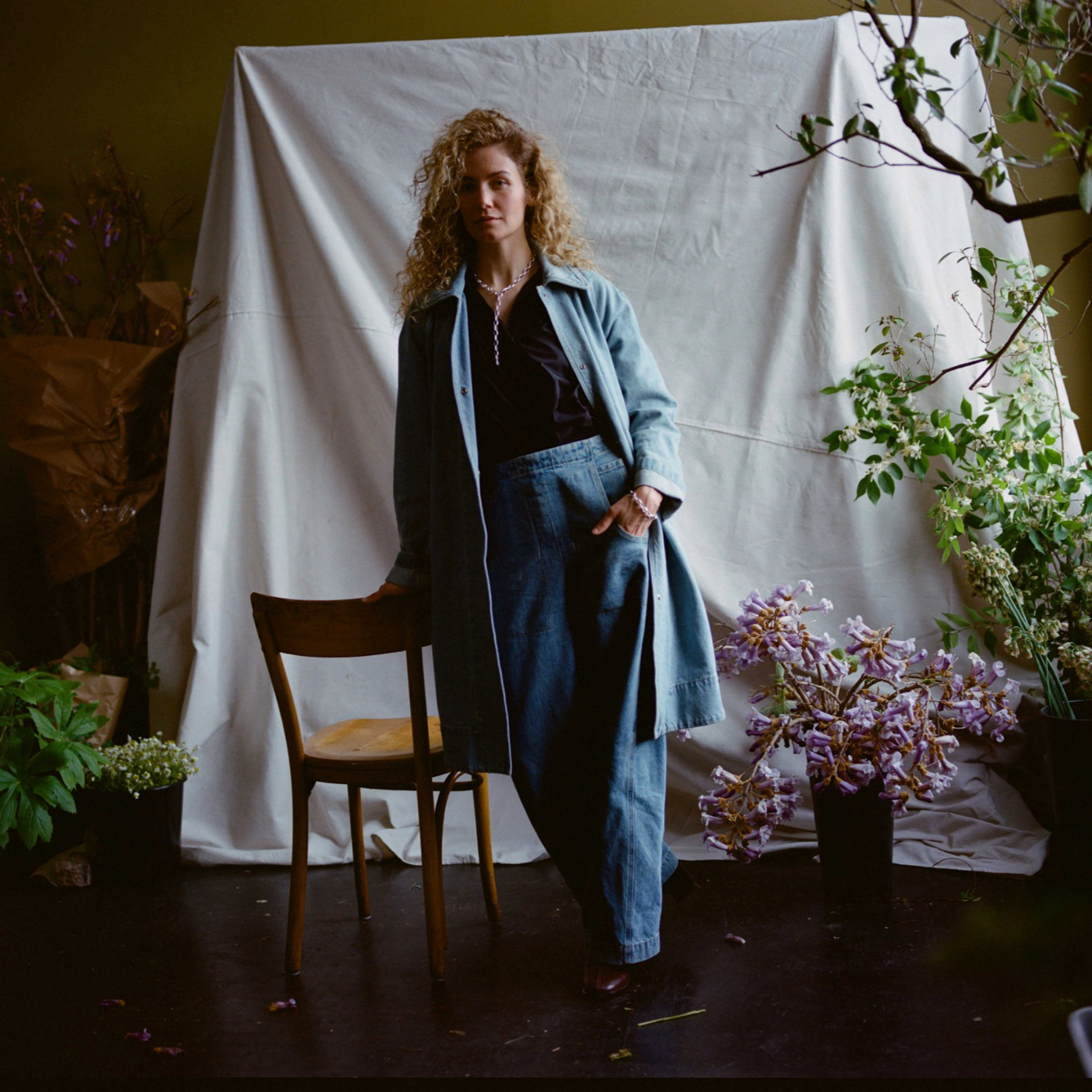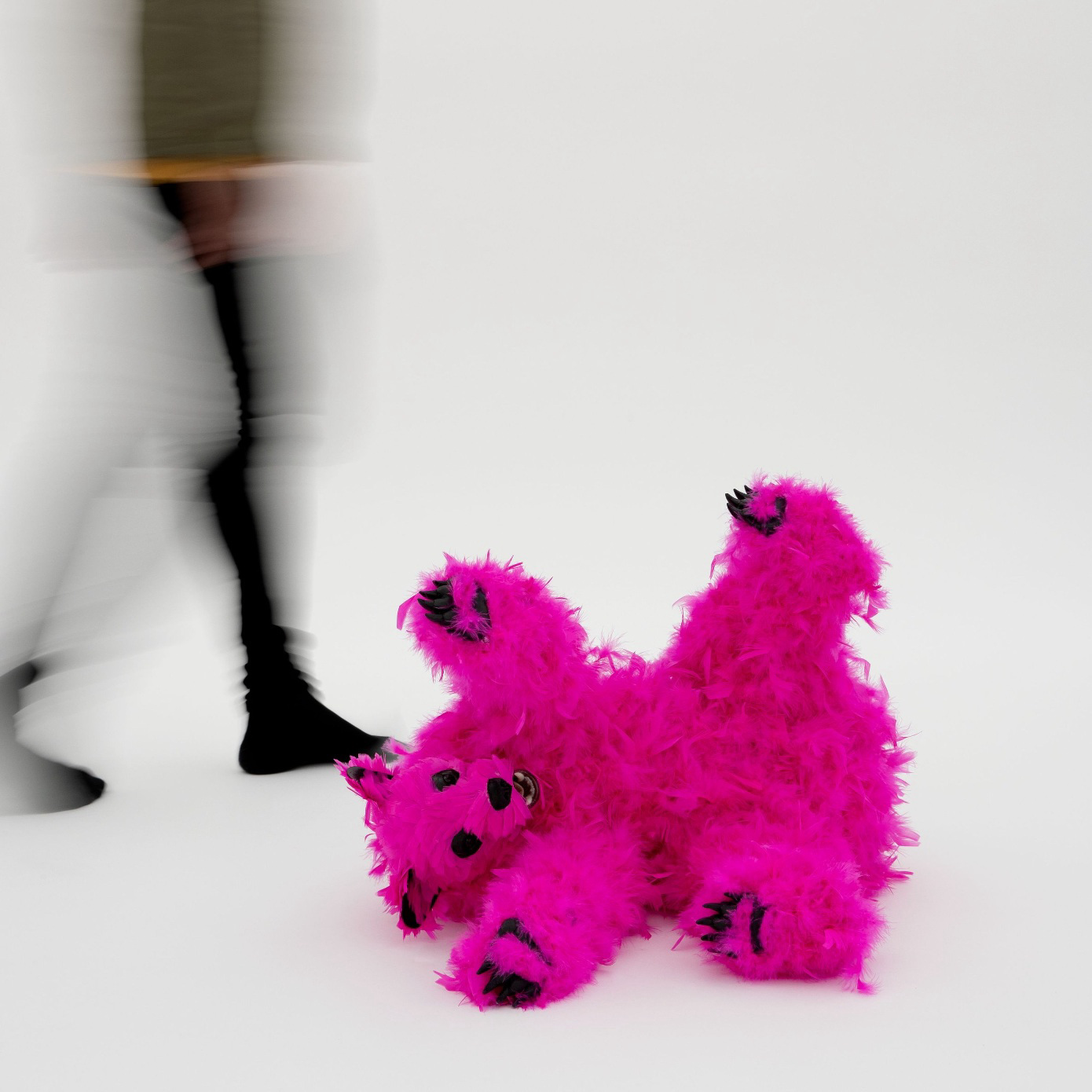
Walking into “Americans,” on long-term view at the National Museum of the American Indian in Washington, D.C., you see a short animated video called The Invention of Thanksgiving. It begins with the “Indian head test pattern,” a graphic black-and-white card used by television stations from 1930 to 1970, featuring an arrangement of circles, crosses and a chief in feathered warbonnet. Someone asks, “What is Thanksgiving?” and the image zooms in to the chief, whose mouth drops down puppet-style to reply, “Thanksgiving is insane.” The video then cuts to a stop-motion collage wryly illustrating the spoken words, which continue: “It’s this huge, incredible disaster of highways and airports and it’s crowded and the weather’s awful. A meal that takes days, sometimes weeks of preparations. Emotional turmoil. Fights...” This slanted playfulness is not what I expected from a video at the National Museum of the American Indian on Thanksgiving—which is the point.
The deadpan voice continues: “The way that it’s corny, it’s cartoonish and kitsch, is kind of a protective layer to sort of not get too direct about it. So, underneath all those things, Thanksgiving is about trying to come to terms with this difficult truth about the United States: that the country is a national project that came about at great expense to Native people. And it’s not enough that we’re a good country, we kinda have to be the best country. But Native people and African slaver y, those two things together, are huge challenges to how you process this.” At this point the animation spells out “Native People + African Slavery” as equating a brain on fire. After walking through the history—that the infamous meal in Plymouth did indeed happen but was completely forgotten until the 1840s, and even then, it doesn’t become the holiday we know today until the 20th century—the narrator concludes: “It was a footnote. And we rescued it from being a footnote, because that has meaning now. So, by the 21st century, Indians are an indivisible part of what creates the United States. It’s not a chapter that happened and it was bad and we got over it. We’re in your head. We’re in your pantry. We’re in your garage. This imagery— representations, advertising—Thanksgiving says, however imperfectly we remember Indians, we’re remembering Indians. With all the problems with it, it’s still a powerful idea, and it’s still powerful to not photoshop Indians out of the national narrative.”
This voice, with its disarming humor and searing intelligence, is that of the exhibition’s co-curator, Paul Chaat Smith, who has been a major figure in Native arts and culture for the past 20 years, ever since he published the magisterial history “Like a Hurricane: The Indian Movement from Alcatraz to Wounded Knee” with Robert Allen Warrior in 1996. This generous, goofy and deadly serious short video is a kind of manifesto for the rest of the exhibition, which invites visitors to engage with the role of Native American imagery, mythology and stereotypes across several hundred years of US visual culture. Chaat Smith’s book of essays, “Everything You Know About Indians is Wrong” (2009), is a primer for the stakes of Native American art and identity in contemporary culture. I interviewed him about his life and work for my new book “What it Means to Write About Art: Inter views with Art Critics,” which is out this fall from David Zwirner Books. The following is an excerpt from our conversation, which focuses specifically on the “Americans” exhibition.
I see your new exhibition at the National Museum of the American Indian, “Americans,” as a summation of a lot of the ideas you’ve worked on for a long time. How do you see them taking shape in this particular exhibition? When we were first starting to plan this show, we were influenced by an important symposium with some of the smartest people in Native studies, called “You Can’t Teach American History without Teaching Indian History.” The punchline is, Of course you can, because it’s done all the time. The level of Indian scholarship now is just extraordinary—it’s like a golden age. Despite that, when these people teach undergraduates, it’s like it’s still 1970. The needle hasn’t moved. Despite all of the public campaigns and great scholarship, in terms of an average American’s knowledge of Indians, it’s still almost at zero. What that tells me is, It’s not about more information, and it’s not about correcting false ideas about history or stereotypes—because we’ve been doing that forever, and it hasn’t moved the needle. The radical notion of the “Americans” exhibition is that we’re telling visitors, You’re part of the Indian experience by virtue of being an American—Indians are so embedded in American national identity, in visual culture, that this really is about you. With this show we’re trying to say, You are part of this construct.
I think in 2004, it would have been a fair criticism to say you could come to our museum and learn about the Northern Cheyenne, and that’s cool and interesting—they had great art and ideas about the universe—but then you could leave and it asked nothing of you. Because it had nothing to do with you—I mean, atomized exhibitions are constructed that way. Instead, with this show, we’re saying, There is no you without us: everything about this countr y is entangled with Indian consciousness, identity, histor y, continuing up to this day—it’s in all our heads. That’s risky, because it’s giving the audience a lot of power.
When I was researching “Like A Hurricane,” I saw that throughout history, there is this recurring thread of feeling sorry for Indians. Back to the very beginning—Lo, the poor Indian! You get people writing in the mid-19th century lamenting, We’re screwing over the poor Indians—it’s so sad—so we made this funny slogan: Lo, the poor Indian! Guilt about Indians has produced disastrous results quite often. The famous thing about the Carlisle School, where Indians were sent off the reservations—when it’s discussed, they often show a cemetery full of dead Indian children. Very subtle. It wasn’t a great place, but what people leave out is that, first, many Indians sent their kids there because it was much better than schools on the reservation; second, private boarding schools all over the world were fucking horrible— think about rich, upper-class English boarding schools and what goes on there. But most important to me is that the guy who ran it, who famously said, “Kill the Indian to save the man,” was a radical Republican antiracist. For his time, he was the most militant Nation-reading Bernie bro you could find. Because these were radical ideas, to take Indians and educate them. Most of the Indian world at that time wanted assimilation—it was just a question of on whose terms, and how much. When Indians today say, We wanted to stay the way we were—that’s against reality, which is really hard to admit.
How has your conception of the audience shifted with this show? This show will get a million-plus visitors a year—all kinds of people, 90 percent of whom are non-Indian. If I’m interested in reaching that kind of mass audience, if it really works, it’ll be something they think about the next day. It’ll be something like, Trump says “Pocahontas,” and they’ll say, Oh, I learned these cool things about Pocahontas at that exhibition. Noticing the place names and the images will reinforce the idea that Indians are part of your life, whether you’re white or South Asian or whatever. That this is part of the experience of living in this country.
I think it’s a pretty accessible thought that when we’ve rained down “Tomahawk” missiles on 15 countries in the last 30 years and called the South Bronx “Fort Apache” in the ’70s, these are not unimportant psychological elements of the country that are worth investigating, without instantly becoming about manifest destiny or white supremacy. How do we avoid that trap? That’s what I’m trying to get to. A lot of it is helping people feel that it’s just kind of cool to think about. Museums are organized around didactics and messaging and all of that—I just think humans are so complicated. I never want to be proscriptive. If I get people with the spectacle, and they’re thinking about how Indian experience is part of their own individual life in a different way—that’s success. I think the shift is thinking more deeply about who the audience actually is and what’s the most impactful thing we can do. To do that turns out to be sailing against the zeitgeist and saying to the people wearing those red “Make America Great Again” baseball caps, Come on in. Learn about this. Be part of it— without irony, without, We’re going to show you how bad you are, how wrong you are. I think that’s what’s radical about it.
Craving more culture? Sign up to receive the Cultured newsletter, a biweekly guide to what’s new and what’s next in art, architecture, design and more.



